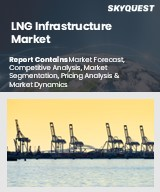
LNG 인프라 세계 시장 규모는 2023년에 652억 달러로 평가되었으며 예측기간(2025-2032년) 동안 CAGR 13.6%로 2024년 740억 7,000만 달러에서 2032년에는 2,054억 2,000만 달러로 성장할 전망입니다.
세계의 LNG 인프라 시장은 보다 깨끗한 대체 에너지에 대한 수요 증가와 세계의 천연 가스 소비량 증가로 큰 성장을 이루고 있습니다. 이러한 선택사항을 제공하기 위해 정부와 에너지 기업은 액화, 재기화, 저장시설에 거액의 투자를 진행하고 있습니다. LNG의 채용 증가도 인프라 수요를 뒷받침하고 있습니다. 모듈식 LNG 유닛과 부유식 저장 및 재기화 설비(FSRU)의 기술적 진보는 프로젝트의 전개와 비용 효율을 개선하고 있습니다. 또한, 특히 아시아태평양과 유럽에서는 에너지의 다양화와 에너지 안보로의 전환이 인프라의 확장을 추진하고 있습니다.
Global LNG Infrastructure Market size was valued at USD 65.2 billion in 2023 and is poised to grow from USD 74.07 billion in 2024 to USD 205.42 billion by 2032, growing at a CAGR of 13.6% during the forecast period (2025-2032).
The Global LNG Infrastructure Market is experiencing significant growth, driven by rising demand for cleaner energy alternatives and increasing global natural gas consumption. LNG offers a more sustainable option compared to coal and oil, prompting governments and energy companies to invest heavily in liquefaction, regasification, and storage facilities. Rapid industrialization in emerging economies and growing adoption of LNG as marine and transportation fuel are also bolstering the infrastructure demand. Technological advancements in modular LNG units and floating storage and regasification units (FSRUs) are reshaping project deployment and cost efficiency. Additionally, the shift toward energy diversification and energy security, especially in Asia-Pacific and Europe, is pushing infrastructure expansion, positioning the market for robust growth over the next decade.
Top-down and bottom-up approaches were used to estimate and validate the size of the Global LNG Infrastructure market and to estimate the size of various other dependent submarkets. The research methodology used to estimate the market size includes the following details: The key players in the market were identified through secondary research, and their market shares in the respective regions were determined through primary and secondary research. This entire procedure includes the study of the annual and financial reports of the top market players and extensive interviews for key insights from industry leaders such as CEOs, VPs, directors, and marketing executives. All percentage shares split, and breakdowns were determined using secondary sources and verified through Primary sources. All possible parameters that affect the markets covered in this research study have been accounted for, viewed in extensive detail, verified through primary research, and analyzed to get the final quantitative and qualitative data.
Global LNG Infrastructure Market Segments Analysis
Global LNG Infrastructure Market is segmented by Type, Production, Distribution, End User Industry and region. Based on Type, the market is segmented into Production Infrastructure, Transportation Infrastructure, Regasification Infrastructure, Distribution Infrastructure, Storage Facilities and Other Types. Based on Production, the market is segmented into Liquefaction Plants, Natural Gas Processing Facilities, LNG Storage Tanks and Others. Based on Distribution, the market is segmented into Pipeline Networks and Virtual Pipeline Solutions. Based on End User Industry, the market is segmented into Heavy-Duty Vehicles, Electric Power Generation and Marine Transport. Based on region, the market is segmented into North America, Europe, Asia Pacific, Latin America and Middle East & Africa.
Driver of the Global LNG Infrastructure Market
The rapid expansion of Germany's LNG infrastructure is significantly supported by the adoption of Floating Storage and Regasification Units (FSRUs). These innovative solutions offer a swift alternative to traditional onshore terminals, which often require years to construct. FSRUs can be operational in a matter of months, providing a flexible and scalable solution to pressing energy demands. These units are either converted LNG carriers or specially designed vessels that function as mobile terminals, enabling them to dock at various ports to receive, store, and regasify LNG for distribution into the national energy grid. This adaptability proves crucial during crises, such as disruptions caused by geopolitical events.
Restraints in the Global LNG Infrastructure Market
The global LNG infrastructure market faces significant restraints primarily due to the high capital requirements for development, which often reach billions of dollars, positioning it as one of the most capital-intensive segments within the energy industry. These exorbitant costs can deter potential investors and hinder the entry of new competitors, particularly in developing regions or markets characterized by uncertainty. Furthermore, the industry grapples with intricate regulatory and permitting frameworks that can cause substantial delays in project timelines. A case in point is the Northwest Shelf LNG expansion in Australia, which encountered a seven-year delay in approvals due to regulatory challenges and political issues.
Market Trends of the Global LNG Infrastructure Market
The global LNG infrastructure market is increasingly characterized by the integration of carbon capture and storage (CCS) technology alongside green technology initiatives. This trend is motivated by stringent environmental regulations and heightened pressure for sustainable practices, with operators enhancing the LNG value chain's emissions profile at liquefaction and regasification facilities. Noteworthy examples include Indonesia's Tangguh LNG project, where CCS is being leveraged to support national decarbonization efforts. As major players pivot towards these sustainable methodologies, investments in green hydrogen integration and low-carbon LNG solutions are becoming prevalent, signifying a significant shift towards environmentally responsible LNG infrastructure development.